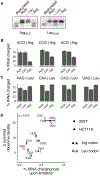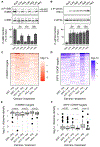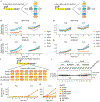Translational Control through Differential Ribosome Pausing during Amino Acid Limitation in Mammalian Cells
- PMID: 30029003
- PMCID: PMC6516488
- DOI: 10.1016/j.molcel.2018.06.041
Translational Control through Differential Ribosome Pausing during Amino Acid Limitation in Mammalian Cells
Abstract
Limitation for amino acids is thought to regulate translation in mammalian cells primarily by signaling through the kinases mTORC1 and GCN2. We find that a selective loss of arginine tRNA charging during limitation for arginine regulates translation through ribosome pausing at two of six arginine codons. Surprisingly, limitation for leucine, an essential and abundant amino acid in protein, results in little or no ribosome pausing. Chemical and genetic perturbation of mTORC1 and GCN2 signaling revealed that their robust response to leucine limitation prevents ribosome pausing, while an insufficient response to arginine limitation leads to loss of tRNA charging and ribosome pausing. Ribosome pausing decreases protein production and triggers premature ribosome termination without reducing mRNA levels. Together, our results suggest that amino acids that are not optimally sensed by the mTORC1 and GCN2 pathways still regulate translation through an evolutionarily conserved mechanism based on codon-specific ribosome pausing.
Keywords: GCN2; amino acid starvation; arginine; codon usage; leucine; mTOR; premature termination; ribosome pausing; ribosome profiling; translational control.
Copyright © 2018 Elsevier Inc. All rights reserved.
Conflict of interest statement
Declaration of Interests
The authors declare no competing interests.
Figures






References
-
- Alexa A, and Rahnenfuhrer J (2016). topGO: Enrichment Analysis for Gene Ontology.
Publication types
MeSH terms
Substances
Grants and funding
LinkOut - more resources
Full Text Sources
Other Literature Sources
Molecular Biology Databases
Research Materials
Miscellaneous

